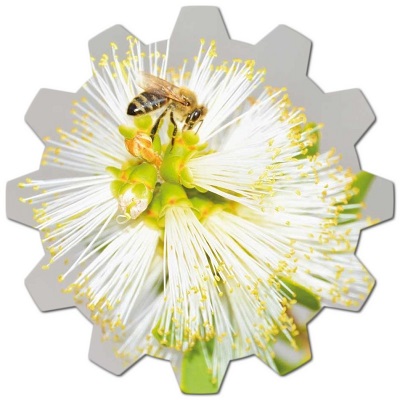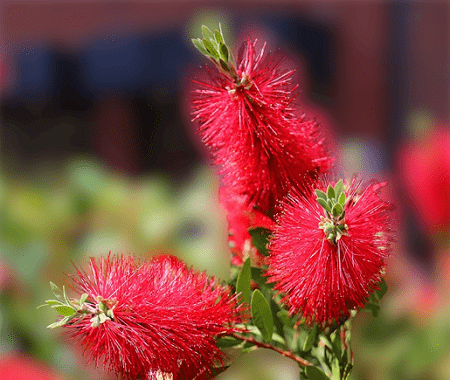Callistemon citrinus, commonly known as the Lemon Bottlebrush, is a species of flowering shrub native to Australia. It belongs to the family Myrtaceae and is known for its distinctive, bright red bottlebrush-like flower spikes that resemble a bottle brush, hence its name. These attractive, cylindrical flower clusters are made up of numerous tiny, vivid red or pink flowers and are a favorite among gardeners and landscapers.
The leaves of Callistemon citrinus are slender and aromatic, with a citrusy scent, giving rise to the common name “Lemon Bottlebrush.” This evergreen shrub typically grows to a height of 6 to 15 feet (2 to 4.5 meters) and has a dense, bushy appearance. It is prized for its ornamental value and is often used as a landscaping plant, both in gardens and along roadsides.
In addition to its aesthetic appeal, Callistemon citrinus is also attractive to pollinators, such as bees and nectar-feeding birds, making it a valuable addition to wildlife-friendly gardens. It is relatively easy to cultivate and is well-suited to a variety of climate zones, provided it receives well-drained soil and adequate sunlight. Overall, Callistemon citrinus is a beautiful and low-maintenance plant that adds a splash of color and a touch of Australia’s natural beauty to gardens and landscapes.

Callistemon, commonly known as bottlebrush, is a genus of evergreen shrubs and small trees native to Australia. They are known for their distinctive cylindrical or bottlebrush-shaped flowers, which are typically red, but can also be found in various other colors. Callistemon trees offer several benefits and are commonly cultivated for both ornamental and practical purposes. Here are some of the benefits of Callistemon trees:
- Ornamental Beauty: The vibrant and unique bottlebrush flowers make Callistemon trees attractive additions to gardens and landscapes. They can add a burst of color and visual interest to your outdoor space.
- Wildlife Habitat: The nectar-rich flowers of Callistemon trees attract pollinators such as bees, butterflies, and birds. They provide a food source for these creatures and can help support local ecosystems.
- Drought Tolerance: Callistemon species are generally drought-tolerant once established, making them suitable for regions with limited water availability. They are a low-maintenance landscaping option.
- Screening and Privacy: Callistemon trees can be grown as hedges or screens to provide privacy and block unwanted views. Their dense foliage makes them effective for this purpose.
- Erosion Control: Their extensive root systems can help stabilize soil, making them useful for erosion control in areas prone to soil erosion.
- Low Maintenance: Callistemon trees are relatively easy to care for. They require minimal pruning and are generally hardy once established.
- Versatility: There are many different species and varieties of Callistemon available, each with its own unique characteristics. This allows you to choose the one that best suits your landscaping needs.
- Cut Flowers: You can use the attractive bottlebrush flowers as cut flowers in floral arrangements, adding a touch of native Australian beauty to your indoor decor.
- Essential Oils: Some species of Callistemon, like Callistemon citrinus, are used for the production of essential oils. The oil is extracted from the leaves and twigs and is known for its pleasant fragrance and potential medicinal properties.
- Fire-Resistant Landscaping: In fire-prone regions, some Callistemon species can be used as part of a fire-resistant landscaping strategy due to their relatively low flammability.
It’s important to note that the specific benefits and characteristics of Callistemon trees can vary depending on the species or variety you choose. Additionally, local climate and growing conditions may impact their performance. Before planting a Callistemon tree, it’s a good idea to research the specific species or variety and consider its suitability for your location and landscaping needs.
What are some interesting facts about callistemon?
Callistemon, commonly known as bottlebrush, is a genus of flowering plants native to Australia. These plants are known for their unique and striking bottlebrush-shaped inflorescences, which are composed of numerous tiny, densely packed flowers. Here are some interesting facts about Callistemon:
- Diverse Species: The Callistemon genus consists of around 34 species, with various shapes, sizes, and flower colors. They range from small shrubs to medium-sized trees.
- Flower Structure: The name “bottlebrush” is derived from the cylindrical, brush-like flower spikes that resemble the shape of a bottle brush. These spikes can vary in color, including red, pink, yellow, and green.
- Attractive to Pollinators: The colorful and nectar-rich flowers of Callistemon plants attract a variety of pollinators, including bees, butterflies, and birds, such as honeyeaters. This makes them an ecologically important plant in their native habitats.
- Ornamental Plants: Many Callistemon species are cultivated as ornamental plants in gardens and landscapes worldwide. They are valued for their attractive flowers and their ability to thrive in a wide range of environmental conditions.
- Evergreen Foliage: Most Callistemon species have evergreen leaves, providing year-round greenery in gardens and landscapes.
- Drought Tolerance: Callistemon plants are known for their drought tolerance, making them suitable for arid and semi-arid regions. They are also adapted to fire-prone ecosystems.
- Pruning: Pruning can help maintain the shape and size of Callistemon plants. Trimming the tips of the branches can stimulate new growth and encourage more prolific flowering.
- Medicinal Uses: Some indigenous Australian peoples used parts of the Callistemon plants, such as leaves and twigs, for their medicinal properties. These traditional uses included treating coughs, colds, and sore throats.
- Conservation: Some Callistemon species are endangered or at risk of becoming so due to habitat loss and climate change. Conservation efforts are in place to protect and preserve these native species.
- Fire Adaptation: In their natural habitats, some Callistemon species have evolved to cope with bushfires. They can resprout from their woody stems after a fire, allowing them to regenerate and thrive in fire-prone areas.
- Propagation: Callistemon plants can be propagated from seeds, but they can also be grown from cuttings taken from healthy, established plants.
- Name Origin: The name “Callistemon” is derived from the Greek words “kalli,” meaning beautiful, and “stemon,” meaning stamen, referring to the attractive stamens of the flowers.
Callistemon plants are not only visually appealing but also play important ecological roles in their native environments. Whether you’re interested in their horticultural uses or their unique biology, they are certainly fascinating plants to explore.
How to care for Callistemon citrinus
Callistemon citrinus, commonly known as the Crimson Bottlebrush or Lemon Bottlebrush, is a popular shrub or small tree native to Australia. It is known for its unique, brush-like flowers that resemble bottle brushes and its aromatic, lemon-scented leaves. Here are some care guidelines for Callistemon citrinus:
- Planting Location:
- Choose a sunny location: Callistemon citrinus thrives in full sun to partial shade. Ensure it receives at least 6 hours of direct sunlight each day for optimal growth and flowering.
- Soil Requirements:
- Well-draining soil: Plant the bottlebrush in well-draining soil to prevent waterlogging, which can lead to root rot. Sandy or loamy soils are ideal.
- Watering:
- Regular watering: Keep the soil consistently moist, especially during the plant’s establishment period. Once established, it is somewhat drought-tolerant, but it still benefits from regular watering, especially during dry spells.
- Mulching:
- Apply mulch: Apply a layer of organic mulch, such as wood chips or straw, around the base of the plant. This helps retain soil moisture, regulate temperature, and suppress weeds.
- Pruning:
- Light pruning: Prune the Callistemon citrinus after flowering to maintain its shape and encourage new growth. Remove dead or damaged branches and trim to shape as needed.
- Fertilization:
- Fertilize sparingly: Bottlebrush plants generally do not require heavy fertilization. You can apply a balanced, slow-release fertilizer in early spring to promote healthy growth.
- Pests and Diseases:
- Keep an eye out for common garden pests like aphids, scale insects, and spider mites. Treat any infestations promptly with insecticidal soap or neem oil.
- Callistemon citrinus is generally resistant to most diseases, but watch for signs of root rot if the soil is poorly drained.
- Propagation:
- You can propagate Callistemon citrinus from cuttings or seeds. Cuttings can be taken in the spring, and seeds can be sown in a well-draining potting mix.
- Winter Care:
- In regions with cold winters, it’s important to protect the plant from frost. Cover it with a frost cloth or move potted plants indoors during the coldest months.
- General Care Tips:
- Remove spent flowers to encourage more blooms.
- Monitor the plant for any signs of stress or disease and address issues promptly.
Remember that Callistemon citrinus can vary in size, from small shrubs to small trees, so it’s important to consider its potential size when choosing a planting location. With the right care and conditions, the Crimson Bottlebrush can be a beautiful addition to your garden or landscape.
Information about Callistemon viminalis
Callistemon viminalis, commonly known as Weeping Bottlebrush, is a species of flowering evergreen shrub or small tree native to eastern Australia. This plant is well-regarded for its attractive ornamental features and its adaptability to a range of growing conditions. Here is some information about Callistemon viminalis:
Appearance: Weeping Bottlebrush is known for its weeping or pendulous branches, which give it a graceful and elegant appearance. It typically reaches a height of 10 to 20 feet (3 to 6 meters) and has a similar spread.

Leaves: The plant features lance-shaped, aromatic leaves that are dark green in color. The leaves are generally narrow and have a pleasant lemony scent when crushed.
Flowers: The most distinctive feature of Callistemon viminalis is its bottlebrush-shaped flower spikes. These spikes are composed of numerous small, tubular flowers and can be found in shades of red, pink, or sometimes even white, depending on the cultivar. The flowers are nectar-rich and attract pollinators like bees, butterflies, and nectar-feeding birds.
Bloom Time: Weeping Bottlebrush typically blooms in late spring and early summer, with the exact timing of the flowering period varying depending on the local climate and growing conditions.
Fruit: After the flowers fade, they are replaced by small, woody seed capsules that contain numerous small seeds. These capsules persist on the plant and add to its ornamental appeal.
Landscape Use: Callistemon viminalis is commonly used in landscaping as an ornamental shrub or small tree. Its weeping habit and vibrant flowers make it a striking addition to gardens, parks, and landscapes. It can also be grown as a hedge, screen, or windbreak.
Growing Conditions: Weeping Bottlebrush is relatively easy to grow and is adaptable to a range of soil types. It prefers well-draining soil and thrives in full sun to partial shade. Once established, it is drought-tolerant, making it suitable for regions with periodic water shortages.
Pruning: Regular pruning can help maintain the plant’s shape and remove dead or damaged branches. Pruning is typically done after the flowering period.
Wildlife Attraction: The nectar-rich flowers of Callistemon viminalis attract a variety of pollinators, making it a valuable addition to gardens that support biodiversity.
Cultivars: There are several cultivated varieties of Callistemon viminalis available, each with slight variations in flower color, size, or growth habit. Popular cultivars include ‘Hannah Ray,’ ‘Captain Cook,’ and ‘Dawson River.’
Weeping Bottlebrush, Callistemon viminalis, is a versatile and visually appealing plant that adds beauty to gardens and landscapes, attracts wildlife, and requires relatively low maintenance once established. It’s a popular choice for those looking to introduce a touch of Australian charm to their outdoor spaces.
